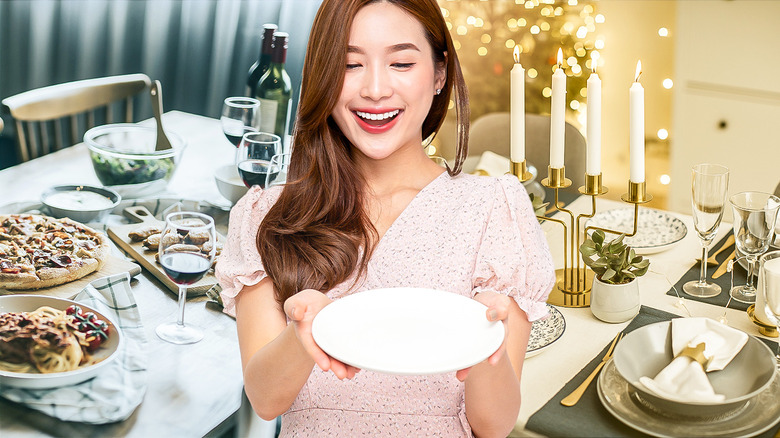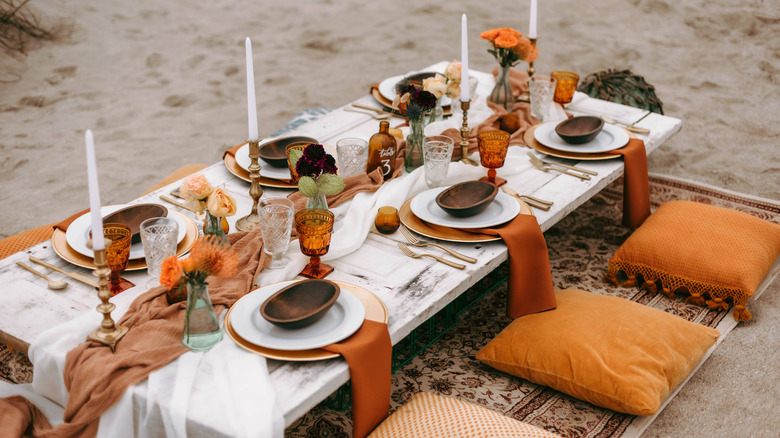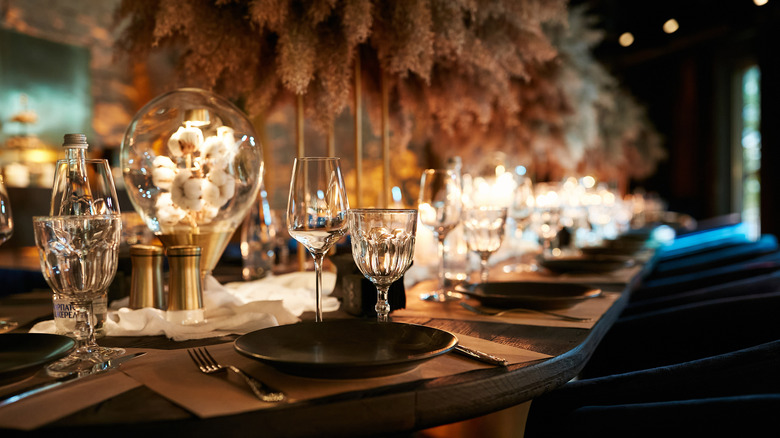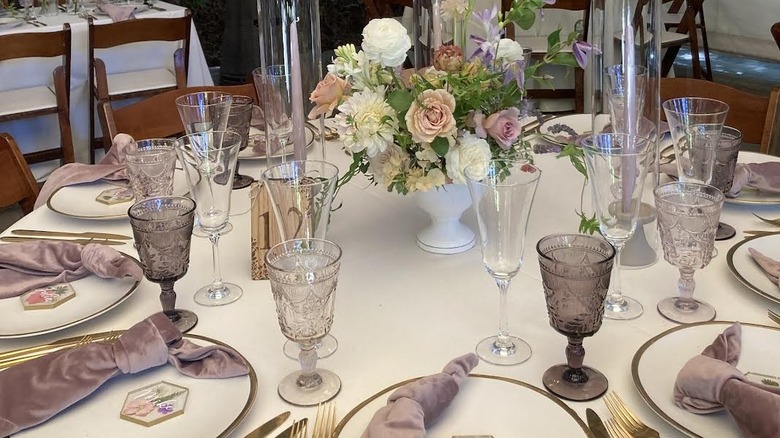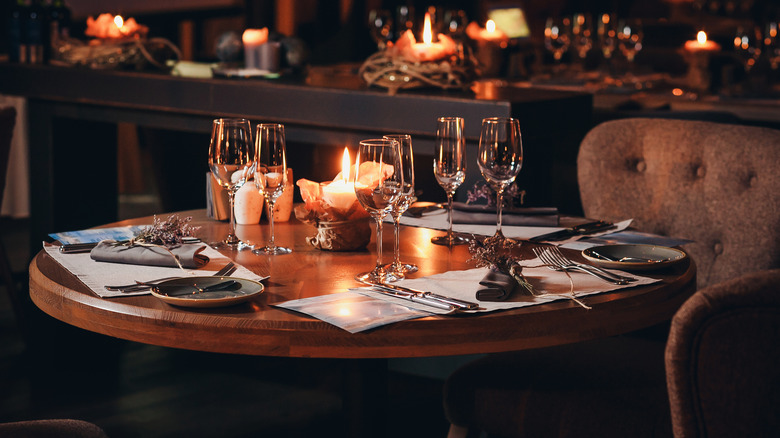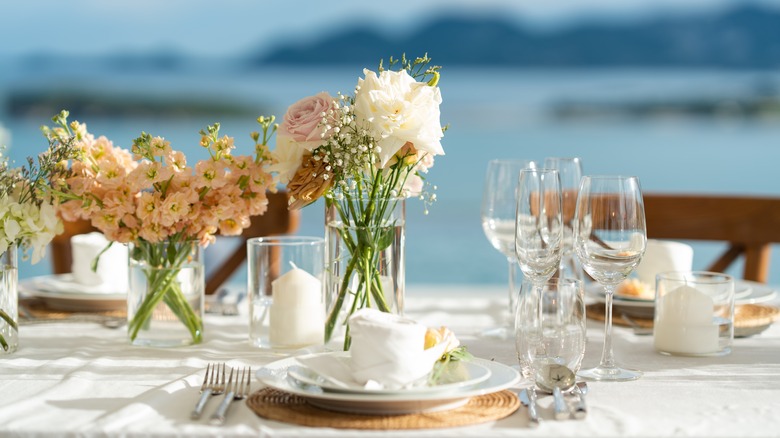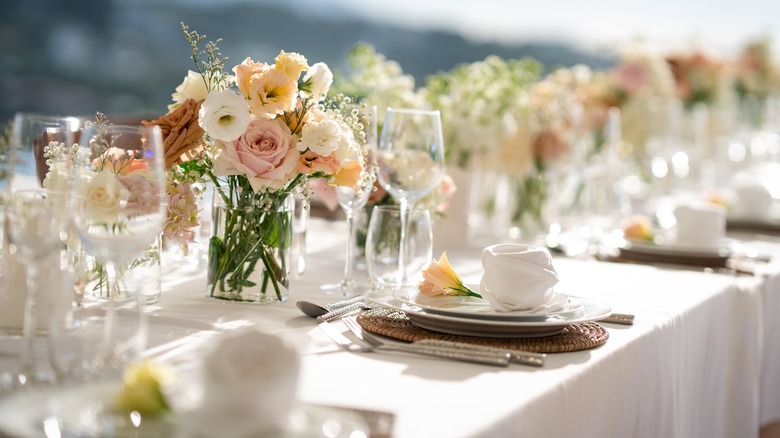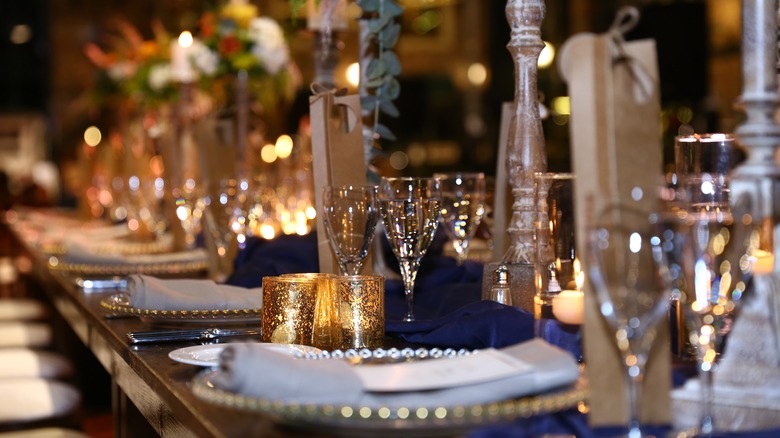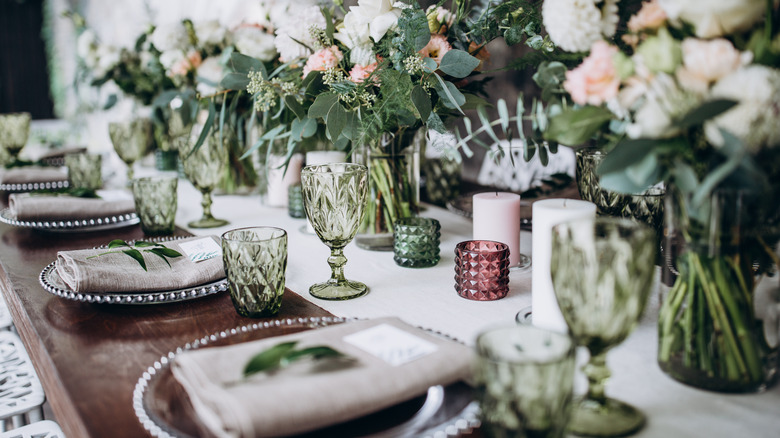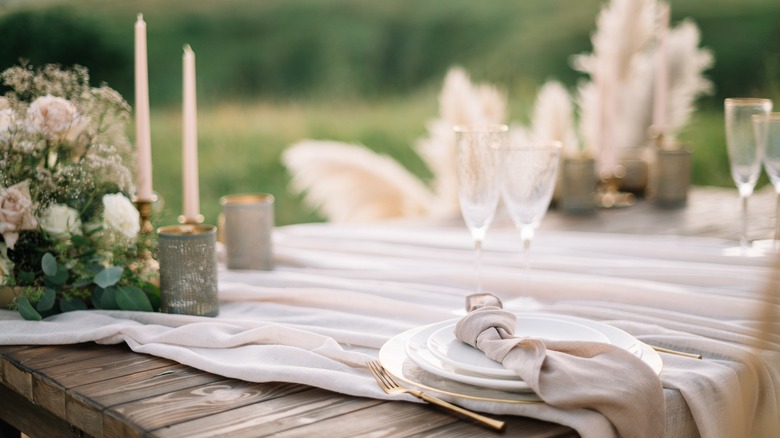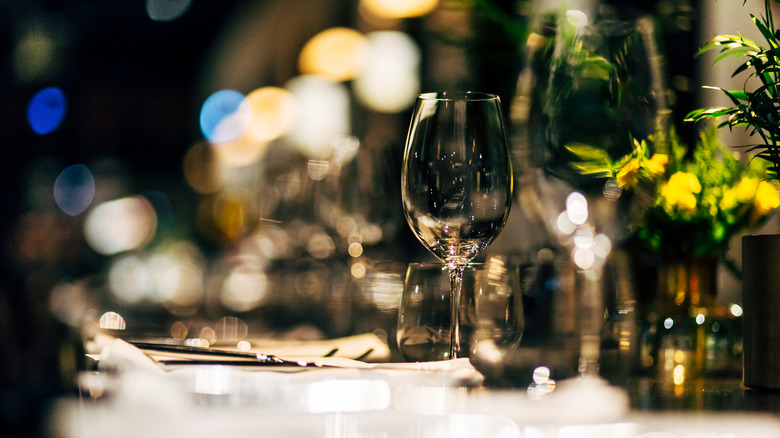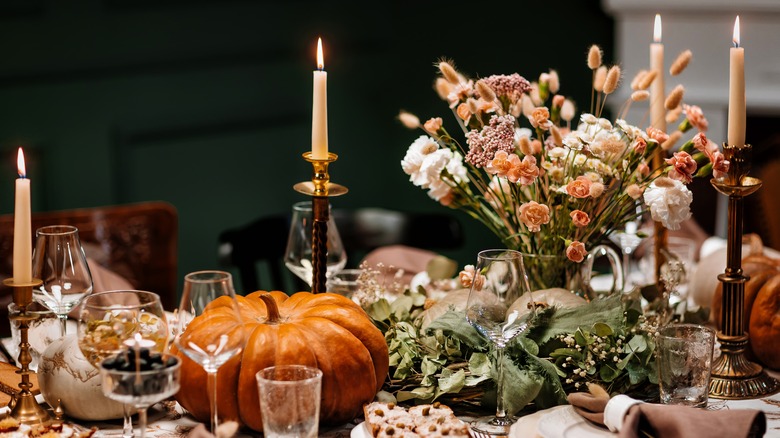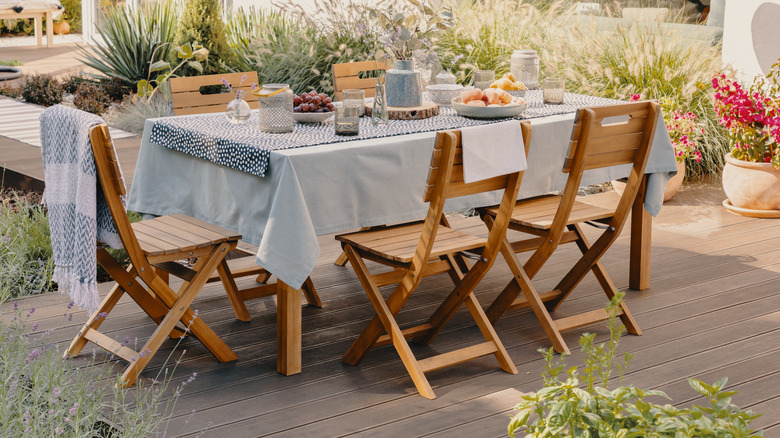12 Expert Tips For A Simple Yet Elegant Table Setting
So, you're aiming to set an elegant table, eh? And no wonder — apart from the meal itself, the table upon which it sits the most important part of a dining experience. In other words, the way that you set up the linens, flatware, plates, glasses, decor, and more all determine the mood of the entire event. And there are plenty of occasions that call for a certain casual air of elegance that only practice can make easy.
Or, in lieu of years of experience, you could always ask an expert and instead learn from all of her best suggestions for setting up an appealing table. And who better to ask to talk about the topic of beautiful table settings than the Chef and Owner of one of California Wine County's premier catering companies, Preferred Sonoma Caterers: Amber Balshaw.
"With setting up dining tables, to me, the devils in the details," said Balshaw. "Right now, I love mixing glassware especially since, to me, glassware is beautiful ... it sparkles, it glows, and you get a variety of heights that catch your eye. Also, as with home design, you want to think about colors and texture; this year, velvet has been really popular and a velvet napkin is just as elegant as it can be. And remember contrast — it's been a lot of beiges these past few years, but ... combining a lavender with gold or a black with gold is just elegant."
1. Know where everything goes
No matter where the dining table is located, a traditional and formal table setting should still include some form of flatware, plates, platters, glasses, and more ... all of which have special places they should and most certainly shouldn't go. Luckily, unless you're hosting royalty or opening a fine dining restaurant of your own, the chances of you needing to know anything more than the basics are pretty slim. Still, there are some rules you should and shouldn't follow for a simple and elegant table setting.
The very basics of a well-set table ask that the plate be centered on the table in front of whatever seat the diner will eventually sit in. To the right of the plate should first be the knife, placed so that the blade side is turned inward to face the plate. To the knife's right, place the spoon as well. The fork, on the other hand, goes on the left side of the plate, typically on top of a napkin, though this rule is more of a suggestion based on decorative preferences.
Glassware has its own set of rules, though all should line up to the top right side of the plate. "Your water glass should always be the easiest to access," Balshaw said. As for tech at the dinner table? "There's always the joke of where the cellphone goes on the table, which is to the left of the fork, by the way."
2. Choose a comprehensive table theme
When you're still in the process of thinking about how you want your table to look, one important thing to consider is the table's theme. This concept of a themed table may come across more obviously in those that are occasion-oriented, such as birthdays, weddings, or holidays. But in the case of upscale events, remember that less is often more, and even if it's a Halloween party, try to incorporate only the most elegant elements and make sure they are consistent throughout the table.
"Though mix-and-match is good, you do need to keep a consistent theme," Balshaw said. To create a table's theme, simply choose an item or two that matches the feeling or vibe of the event in question. Take Thanksgiving, for example — when creating a Thanksgiving-themed table, consider the words or images that pop into your mind ... harvest, bounty, abundant and overflowing cornucopias, all with splashes of orange and red like the leaves changing on the trees outside, perhaps? So long as everything on the table follows one consistent theme, it should look elegant and clean.
3. Mix and match items (within reason)
Once the theme of your table is set, so can the actual details of your table setting. Rather than thinking of big ideas, you can create an interesting aesthetic simply by matching most of the elements with the table's theme. And since everything is cohesive and simple, it makes throwing in one statement piece such as an eye-catching goblet a whole lot easier and more elegant as well. This is especially true with items like glassware, playful plates, colorful floral arrangements, mismatched napkins that still fit the theme, and so much more. These mismatched additions to dining tables can be the game changer that adds some pop of color, contrast, or just a little bit of visual interest without diminishing the simple elegance of the table.
"For setting an elegant table, mix-and-match makes for a beautiful contrast," suggested Balshaw. "Choose one or the other when it comes to flatware, plateware, and with wine glasses too –- if I choose to make the water glasses different, then I'll keep the flutes and wine the same because you don't want it to look hodgepodge."
4. Avoid clutter at all costs
Nothing ruins an elegant eating experience quite like a table so cluttered you can't even find a place to put down your cocktail. And any fine dining restaurant worth its salt will ensure its guests have enough space to actually enjoy their evening. In this same vein of thought, any and all elegantly set dining tables at home are not complete unless there's room to breathe when everyone is seated and ready to eat.
"Less is more," agreed Balshaw. "I don't like a crowded table because there's nothing worse than sitting down to a table, and it's crowded, plus you don't know how to use half of what's there."
So, take away those extra bits of decor and get a table extender if you need to, because anything is better than bumping elbows with each other when you so much as cut into a steak or reach to pass the pepper.
5. Aim for no more than three colors
For an elegant table, knowing when to exercise simplicity is key ... especially in the colors you choose. Balance is everything, and understanding the basics of what matches and what does not. On one hand, you don't want a table devoid of all colors at all. But on the other hand, add too many colors to the table and the ambiance will go from elegant to a lot real fast. The trick is to keep the eye intrigued, not overwhelmed. Considering the season and/or the occasion when choosing the right color palette for the plates (plus how to pair plate color with the food you're serving), linens, and decor are all-important for a cohesive dining experience.
"You could look at the table and it could just be so complicated that you don't enjoy looking at it; we see this a lot when people go too wild on things like color schemes," said Balshaw. "I absolutely recommend no more than three colors. Start with a lighter color on your base linen because dark colors make it feel more deep and moody. I like to pull in the darker color after, with an element of like ... a dark purple, then bring in a brighter pop of a color like lavender with the napkins."
6. Go for floral decor
Flowers, wreaths, and other botanical arrangements are a timeless and traditional decorative element that can brighten and add a touch of elegance to any table setting. Whatever the season, there are a ton of gorgeous bouquets and arrangements that can take the table you're setting from average to absolutely splendid in no time at all. From jaunty sunflowers in the late summer and early fall to wreathes of holly around the holidays and even delicate live orchids of early spring, you simply cannot go wrong with flowers (barring allergies, that is).
"Flowers you can always count on –- I have never seen a live flower that didn't enhance an elegant look," said Balshaw. "Or any look. And even color schemes I would never put together, like honeydew green against a teal blue, they can be balanced when you bring flowers between to help soften everything." And if flowers are really speaking to you and you want to add them just about everywhere you can on that dining setup, consider this creative floral decor game-changer of making floral ice cubes for your drinks.
7. Put your personality into it
If you're throwing a dinner party and want to add a touch of elegance to the design, then a good way to get started is to let it be a reflection of the naturally elegant aspects of the host(ess). And even for those who are hesitant to access their inner expression, especially in an elegant sense, don't worry — everyone has something that helps reflect an aspect of their personality. Belshaw has seen books incorporated for the bookworm brides and grooms' special day, or music sheets strewn about as an elegant but eclectic touch of personality to a table.
Balshaw emphasized that it is important to really represent your own special flair for the table's decor: "What is your personality? Who are you? I love to get to know the people and what they like ... I see so many tables, but the ones I remember are the ones that are unique."
In terms of finding words that describe the look you're going for with your elegant table setting, Balshaw asks her clients the following: "Are you more contemporary, organic, timeless? Come up with those and just go from there." With those kinds of descriptions, you can start setting a simply divine dining table that is a real reflection of its maker.
8. Rethink putting platters of food on the table
Though many of us have at least a few fond memories of dining tables piled high with generous platters of fabulously delicious food, this food-forward method of dining is not quite right if the aesthetic aim for the evening is one of elegance. Rather than letting the food get in the way of the evening, consider ways to balance full bellies and plates with not having to have the whole hog on the table to prove it.
"Having tons of platters of food means there's so much space between everyone as they eat and no room to put anything down, and you feel cramped," Balshaw explained, going on to speak about the ways to mitigate situations such as this. One would be to serve the protein and perhaps a carb while in the kitchen and then let the sides sit on the table for individual serving options. Otherwise, there's always the option of plating everyone's dishes for them, which can look very elegant if done well.
9. Quality, not quantity
For an elegant and simple dining table aesthetic, there is nothing that lends more perfectly than the simple principle of quality over quantity. The same can be said for the dishes themselves and the people you invite to share in a meal at your table to begin with. And, as with all things in life, there is a balance to be struck in this practice as well. In other words, do not go too far in the other direction and end up with a sparse table decorated only with pure gold goblets and plates and not much else.
"Less is more," emphasized Balshaw. "Pick quality pieces and show those off. You do not need to have a cut crystal wineglass for everyone when a nice wineglass is acceptable." And since we've already established that clutter is a faux pas, it makes sense that the few items that are on the table should be of as high a quality as you can comfortably procure.
10. Don't let a dirty dish slip by
There's nothing worse than sitting down at a table and seeing a smudge on your fork or a fingerprint in your wineglass — it is, quite simply, unappetizing. "I should not be able to do an NCIS recovery from the fingerprint on your glass," said Balshaw.
For plates and utensils, just be sure to give them a thorough wash and dry, and try to carry them from the underside (to keep your hands from touching the top of the plate). Glassware is the most difficult to keep pristine since it retains a significant visual impression of any imperfection on its surface. So, make sure to double-check all those glasses on the table if you're going for an elegant impression.
And if you're struggling to get those dishes looking squeaky clean because of annoying water marks, try out this coffee hack for preventing watermarks on dishes while they dry — it's amazing what a few grounds can do to keep dirty-looking dishes far away from the dinner table.
11. Ditch the eye-catching item
When you're setting an elegant dining table, it's important to keep simplicity and understated quality as the key components. Balshaw suggests a unique trick to finalize an elegant look in a dining table: "I use this rule for getting dressed for a party as well — once you're dressed, you look back and then look again, and whatever immediately catches your eye needs to go. The first thing you see is the first thing the [guests] will see, and the same idea applies when setting an elegant table."
So, when you've finished putting all the pieces in place on top of your table be sure to do the turn-back test: turn away and look briefly back at the table -– if something immediately caught your eye, consider ditching it entirely or moving it off the table and to another part of the room. This way, you can tie in the theme without cluttering and confusing the table (and its diners).
12. Double-check in the right light
One mistake that almost everyone makes when setting up an elegant dining table is that they do not take the time to consider the change in lighting from when they are choosing items for the table versus when they are actually going to set it. If you're eating outside at noon, for example, be sure to look at the color of the tablecloth outside at noon rather than in the kitchen the night before since lighting and timing make a huge difference in decorative impact.
"Make sure to view your colors where you will be viewing them throughout the night," said Balshaw. "You don't want to sit down at a white tablecloth on a bright sunny day, for example."
If the colors are too dark, the dining table could appear drab. Too light, on the other hand, and the linens can reflect the sun up into your face and make enjoying a meal almost impossible against the glare of a good bleach-starched tablecloth glistening in the sunlight.
